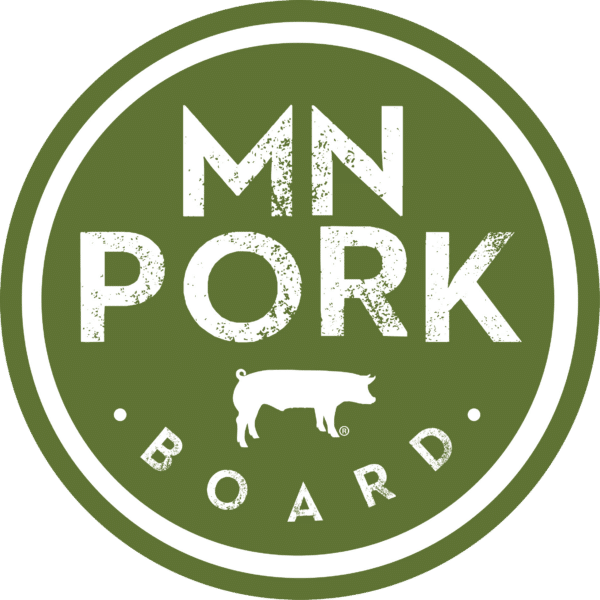
The Minnesota Pork Board recognizes the Anderson family as this year’s Family of the Year award recipient.
Pride for what came before them and a desire to continue the legacy centers the work of the Anderson Family and Anderson Farms of Belgrade, Minnesota.
The fourth and fifth generations of the Anderson family. John and wife Shirley along with his late brother Jim and his wife Sue farm alongside Jim’s sons Grant and wife Heidi, Isaac and wife Shannon and Noah and wife Amanda as well as John’s daughter Erin and her husband Wyatt. The family works together to raise pigs, cattle and diversified crops in a variety of new and inventive ways. Like generations before them, the Andersons approach farming with a hunger for growth and efficiency, exploring niche markets and new ways of thinking, bettering themselves and those around them.
From One Generation to the Next
In 1889, brothers August and Charlie Johanson immigrated from Sweden, taking the last name Anderson upon entering Ellis Island. Settling in Minnesota where the farm stands today, each brother bought 160 acres and farmed separately. The farms consisted of dairy cows and a few pigs and chickens. As the first generation of the farm, August and Charlie were pioneers from the very beginning, setting up future generations of Andersons for success.
August’s son Carl, born 1903, and his wife Ethel marked the second generation, farming through the difficult years of the ‘dirty thirties’ and the Great Depression. With the farm located on sandy soils, Carl relied mostly on the beef cow herd for income. He was fortunate that most of his ground was in pasture or hay which helped preserve the soil during the dry years.
In 1929, Carl’s son Jack was born. With his wife Viola, Jack was innovative, growing both the land and livestock practices through the ‘50s and ‘60s. In 1968, Jack bought his grandfather Charlie’s farm, expanding his farming operation. In 1969, he started irrigating with a labor intense traveling gun. Being a leader for irrigation practices, Jack helped organize the Irrigation Association of Minnesota and served as its Executive Director throughout the ‘80s. In 1990, at the age of 60, Jack died in a farm accident. Displaying leadership and passion for his farming practices, it’s no surprise Jack passed the same values on to the next generation, who still farms the land today.
Brothers Jim and John led the fourth generation of Andersons on the farm. Jim graduated from South Dakota State University in 1975, marrying wife Sue in 1978 and moving onto Charlie’s farm. John attended North Dakota State University in 1980, marrying his wife Shirley in 1985 and moving to the home farm, joining the partnership with his father and brother. With the passing of their father Jack in 1990, Jim and John, along with Sue and Shirley, shared a common goal of growing the farm. Recognizing they could not do this on their own, they started building a dedicated team of employees.
By this time, the family was farming crops, beef cattle and pigs. Jim and John decided to sell the beef herd to focus more on crop production. Eventually they brought the cattle back into the farm. During the ‘80s and early ‘90s, the Andersons expanded the pigs and cattle feeding to outside lots. In 1996, they built their sow unit that is still in operation today. On the crop side, the Andersons started raising navy and pinto beans in the early 1980s. They also started raising sugar beets in 2000. Following the ambition of their ancestors, the Andersons purchased the local grain elevator in 1998, which they still operate today.
Today, the fifth generation of Andersons includes four young farmers: Grant, Noah, Isaac and Erin. Since joining the farm, the sow unit has expanded to house 2,500 head. The cattle feeding has been moved inside, and land has expanded. Continuing the adaptable, innovative farming approach, the Andersons are keen to take advantage of emerging technology.
“Everything we do, especially on the crops side, is driven by technology,” John said.
‘Never stop improving’ is a fitting phrase for the family, always looking for the next wise decision to improve their farm’s performance and health of the animals and land.
“We want to get more efficient and use less resources to grow more crops for more food for more people, that’s the bottom line, and be good stewards of the land and animals along the way,” Grant Anderson stated. “In order to preserve the farming legacy that we have go onto sixth, seventh, eighth generation here which I’d sure love to see happen, we need to stay in that top 30 – keep evolving, keep adopting the new technology, and new ways of doing things.”
Variety of Farm Enterprises
Throughout the generations, Anderson Farms has adapted with the times to be most efficient in their practices. With sows, research pigs, finishing pigs, cattle, a variety of crops and a feed mill, the family is passionate about constantly evolving and being skilled in all aspects of their farm.
“Part of our philosophy is we probably aren’t going to be the biggest at anything, so we try to add value to everything we do. Whether that be hogs, cattle or land,” John said.
As many farmers can attest to, the 1980s were a difficult time in pig farming with challenges such as worms, mange and other disease outbreaks like PRRS.
“We decided we either needed to get out or do something different. We needed to make health a priority for raising pigs,” John stated.
With this decision came the building of the first sow barn in 1996 which held 1,000 head. Two years later, the barn increased to hold 1,600 sows. Nine years after that, the barn was increased further to house 2,500 sows. Later in 2014, the Andersons added a gilt developer unit (GDU) and increased farrowing even further.
Genetics is another component the Andersons are involved in. For the first nine years, beginning in 2001, the family started partnering with the Thunderbird Colony in South Dakota to improve their genetics. In 2010 they realized they needed to be aligned with a bigger company in order to stay on top and be a nucleus herd. This was achieved in cooperation with the family-owned company DNA Genetics, who they still partner with today. Gilts from Anderson Farms have been exported to a variety of states as well as to Canada, Mexico and Europe for their high-quality purebred genetics.
Anderson Farms also specializes in medical research pigs. Starting with a Midwest research farm and now partnering with a number of companies such as Reprise Biomedical, pigs are utilized to help with innovative medical and research developments. For example, pigs’ livers are used to make a mesh that helps pack a wound so the body doesn’t reject the material, meaning it does not have to be removed. They also make ‘derms’ which are placed on injuries such as burns or deep cuts which become part of the body over time. Another research use of the Andersons’ feeder pigs and isoweens are animal health trials.
“Medical research is one of those things where it is high margin, but not many pigs involved,” John added.
On the finishing side, the Anderson family has made many strides to update their operation. They have the capacity to feed half of their production, with the other half being raised by contract partners. Valuing the improvement of biosecurity efforts is seen by restructuring barn layouts and supplying all sites with Secure Pork Supply plans. Improving equipment in the barns such as tube feeders and updating controllers also helps the family be as efficient as possible. All sites are now equipped with showers for employee use as well. In addition, all trucks are required to be washed and dried before they are allowed to go back to the barns for a new load.
The Andersons also feed non-hormone treated cattle (NHTC). They finish 2,200 head cattle per year, which all are exported to Europe. Most of the cattle are sourced from Scott Rach in Pryor, Montana, all having to be Sampson verified with an EID tag.
The Andersons farm about 9,500 acres of crops including corn, sugar beets and kidney beans as well as small grain including wheat, oats, dry hay and rye. Irrigating remains a continued practice with 90 center pivots using well water.
Finally, the feed mill that the Andersons operate has enough storage to feed all the livestock for one year. The feed mill is fully automated and can mix around 550 tons per week, delivering feed in a 60-mile radius for Anderson Farms.
The Community and Beyond
Deeply rooted in their community, Anderson Farms values the gift of donating time and resources to help those around them. Each Christmas, pork is packaged and donated to local schools and essential workers. The family hosts school field trips of all ages, including hosting groups from colleges and universities as part of alumni support. Employee appreciation gatherings, participation in local parades, and various donations and volunteering opportunities as well as church involvement all make up the Andersons’ community outreach effort.
The Andersons contribute to not only the local community, but the state organization as well. John served on the Minnesota Pork Board of Directors for six years, including positions as vice president and president. Dave Preisler, past long-time CEO of Minnesota Pork, reflected on what comes to mind when he thinks of the Anderson family.
“First of all, John is an NDSU grad, which makes it to where you’re going to be pretty good at whatever you do anyway,” laughed Dave. On a more serious note, he stated “when I look at what they do farming wise, it is extremely evident family is first. I also think of innovation. Really being open to latching onto something new, whether that is new technology or business innovation. Their community reputation is really positive, they are thought of well.”
It is apparent the Anderson families are deserving of the Farm Family of the Year award. Whether they are improving their farming practices, adding new technology or giving back to their community, the Andersons represent their values and commitment for future generations of family farms.
